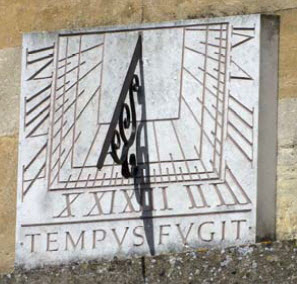 |
| The Local Time is Saturday, 27-Jul-2024 07:08:53 CEST |
Two Sundials in Woodstock |
|
|||
| YOU ARE HERE: Main Home Page > Strange Things > Woodstock Sundials |
|
|
The Two Sundials in a small Cotswold TownWhy should there be two nearly identical and remarkably accurate, sundials in a small Oxfordshire town? Walking into the lovely Market town of Woodstock in Oxfordshire by either of its entrances from the main road, is always delightful. On Woodstock Town Hall there is a dial which is carved into a block of white stone or perhaps marble.
It was way back in 1998 that dial enthusiast Anthony Capon first drew attention to the fact that the Town Hall dial was unusual in that the block is placed on a ledge and turnedor canted, to make it read correctly. The suspicion then was that it was a dial that had been made for another location. However, closer inspection
shows that the so called limiting
hours are not 6am and
6pm as they would be for a
direct South dial and the gnomon
is not exactly placed
The Church was built in the 12th century, in the reign of King Henry II, as a Chapel-of- Ease to the Parish Church of St. Martin, Bladon. It was probably constructed for the convenience of the Court since the King was often in residence at his Royal Manor of Woodstock. Long after the church was built – though when we do not know – the sundial was installed, It was moved to the West in the 19thC after some emergency building works and there it remains to this day. It only takes a moment to realise that the Town Hall dial is a near complete copy of the St Mary Magdalene dial (even down to its backward lettering for 7am and 8am!) rather than one delineated for its location. In fact this copy is probably relatively modern. It is known only from the 1950s and was 'redrawn' in the early 1990s. See what you think from the pictures here. This article was kindly submitted by Mr. Patrick Powers |
|||||||||||||||||||||||||||||||||||||||||||||||||||||||||||||
|
|||||||||||||||||||||||||||||||||||||||||||||||||||||||||||||
Strange Things in the Cotswolds |
|||||||||||||||||||||||||||||||||||||||||||||||||||||||||||||
| This page last modified Thursday, 11-Feb-2021 13:25:07 CET | |||||||||||||||||||||||||||||||||||||||||||||||||||||||||||||


